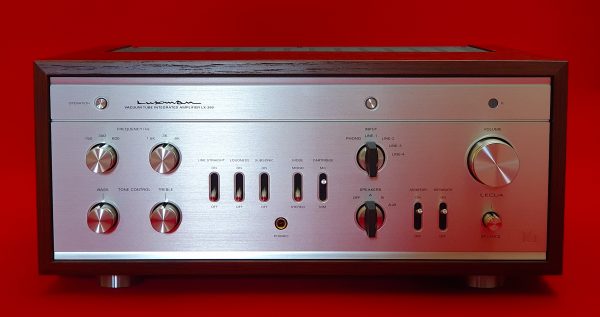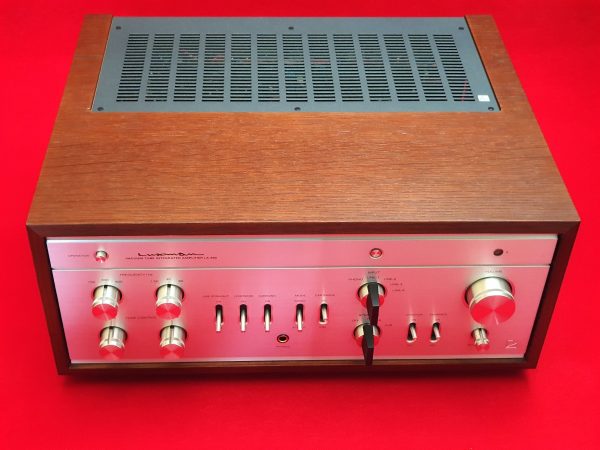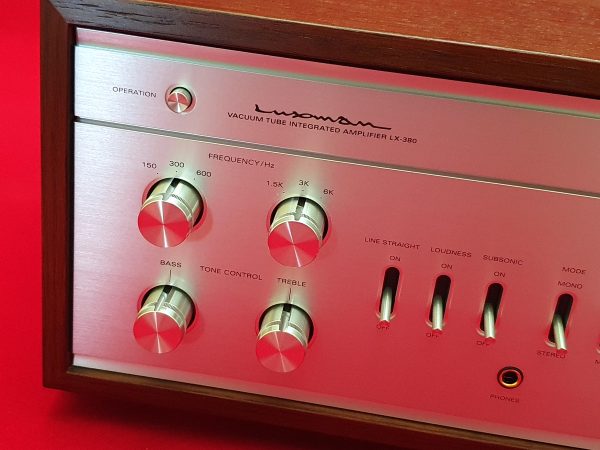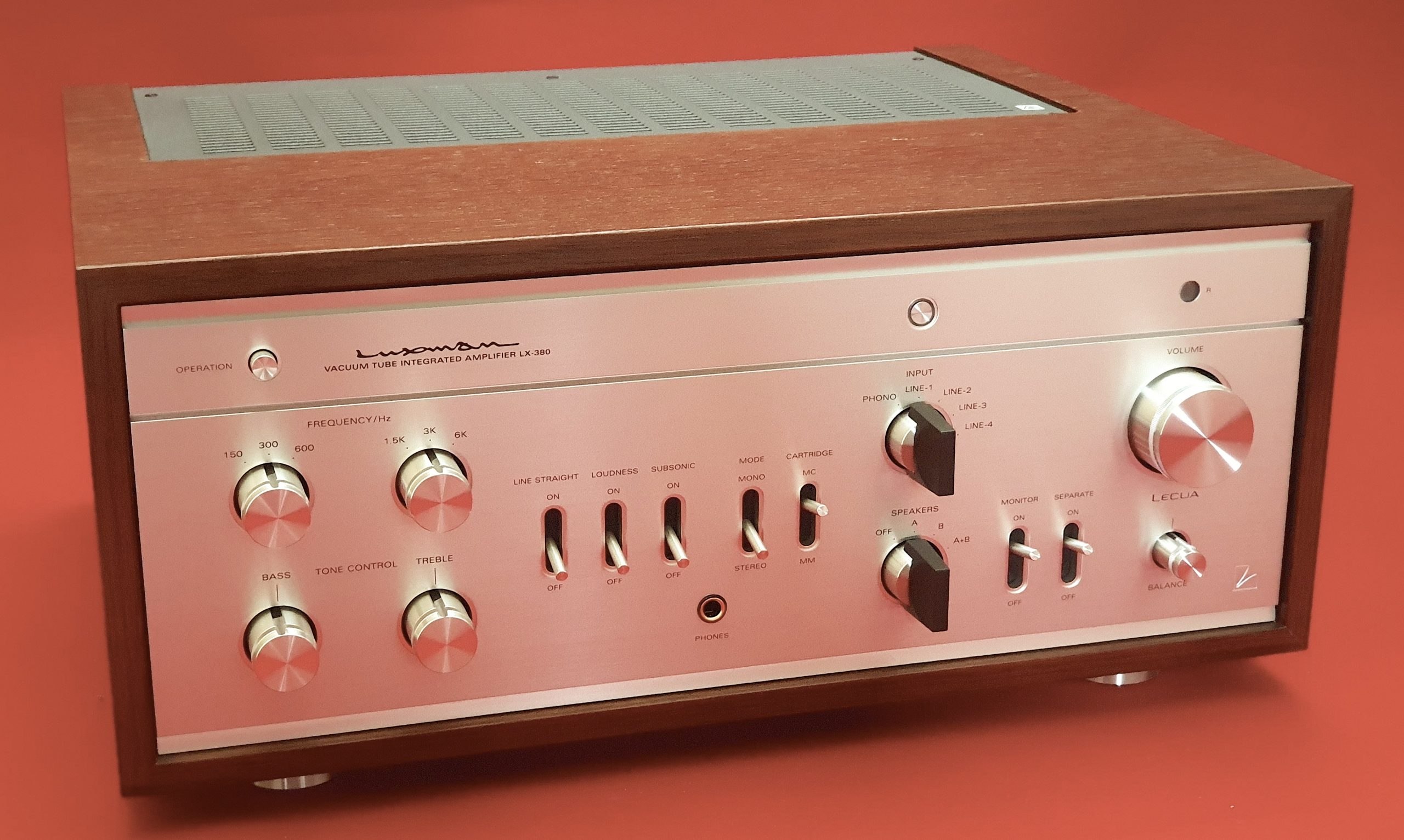LUXMAN LX-380 vacuum tube integrated amplifier
+ Excellent built-in phono stage; vintage good looks; unadulterated and transparent voicing; dynamic and punchy; solidly built with quality switchgear.
– No tube lushness nor is it warm sounding; no DAC module option.
Sound: 8/10
Value: 8/10
ARE you a retro-phile? Tube equipment? I don’t know what makes you tick but reading the editor’s review checklist certainly made me do a Kessel Run to his doorstep to collect the Luxman LX-380 integrated tube amplifier. The name Luxman resonates with many of us who grew up in the 1980s, during the pinnacle of Japanese hi-fi history with so many legendary models coming out during that period.
Luxman stuck to the age-old proven push-pull formula with three medium-gain ECC82 double triodes as driver tubes and four 6L6GC beam tetrodes as power tubes. Although I’m no stranger to the popularly used EEC82/12AU7 tubes, my tube journey was crafted by 300B, 211, 845, KT88, 6550 and 45/245 power tubes hence the LX-380 would be an exciting discovery for me. The pièce de résistance is the semiconductor-based LECUA 88-step computerised control attenuator that delivers a consistent sound quality through the volume range.

Having experienced the renaissance of vintage Japanese hi-fi equipment in recent times, with the Sansui AU-X1 integrated amplifier, CEC optical transport, Technics SL-10 turntable and other vintage items becoming permanent fixtures in my system, I am increasingly drawn to the bang-for-buck value of older gear.
SETTING UP
The packaging is what you would expect from a prime manufacturer. The LX-380 comes double-boxed and the 17.6kg unit is securely wedged in place with minimal use of the unavoidable non-degradable styrofoam. The amplifier itself is carefully wrapped in a washi paper-like sock with an elastic rim to fit snugly.
Once unsheathed, it’s a sight to behold. One melts just looking at this beautifully crafted piece. It looks much like the vintage Luxman L-480 or legendary Luxman SQ-38U, with a wooden frame around the brushed aluminium fascia and blacked-out backplate.

The LX-380 is a tall fellow, measuring 197 x 440 x 403mm (h/w/d), so you need a rack with sufficient headroom. It is about the same height as the Sansui AU-X1 and Vitus RI-101 in my living room, hence it ended up on the TAOC rack, where these amps once sat. My faithful Sonus Faber Guarneri Homage speakers were hooked up to the Luxman.
The faceplate is a visual delight, especially with name “Luxman” etched in cursive on it. The vintage theme continues with the array of meaty rocker toggle switches flanked by polished round knobs for tonal and volume controls, whilst the source selectors have contrasting flat pinch-knobs. I like the micro-relays built into most of this amp’s switchgear to mute the amplifier momentarily for circuit protection when you make changes to the amplifier setting.
Hooking up was a simple affair. All connectivity on the rear panel are RCA terminals, no XLRs. You will find the source input terminals grouped together on the left. The rightmost pair of input terminals is the phono stage (yes, the LX-380 has one on board), distanced away from the other five sets of inputs, and located a finger’s width from the ground terminal.
If you have taken up digitising your vinyl, there is a pair of recording and monitoring outputs to connect to your recording device. There is even flexibility to use the LX-380 as a dedicated pre or power amplifier through the pre-out and main-in terminals. There are two sets speaker terminals catering to bananas, spades, pins or even bare-wire connectivity.

The switchgear exudes quality and paints a smile on your face when powering up by pressing the softly-damped power button and rotating the input selector to Phono with just the right feedback as it locks into place. Getting the integrated amplifier ready is like going through a pre-takeoff procedure. What a joy indeed! Monitor off – check, Separate off – check, Line Straight off – check, Mode Stereo – check and Cartridge MM – check. We are cleared for takeoff, I told myself.
LISTENING
First impression counts. Being mindful that this was a brand new unit, I was impressed the moment the needle hit the groove. This baby has juice, some real 20 watts of real power – my 86.6dB Guarneri speakers truly started singing. The first thing that caught my ears was the quality of the bass notes. It was reminiscent of the manner in which the Sansui and Vitus handles the Guarneris – it’s not easy to feel the double bass strings but I assure you that I was feeling them through the puny 6.5-inch woofers. The LX-380 grips the notes with such authority and controls the decay, to the extent that I had a peek into the chassis to see if I was listening to a good solid-state design. Mighty impressive for a relatively low output tube amplifier.
I was playing Spotify through Chromecast Audio for about eight hours daily, not only to run in the unit but also to have it sufficiently warmed up for the nightly crunch over a period of two weeks. Switching between source equipment used, I found the LX-380 to be fairly transparent. If you feed it peanuts, you get monkey shrills. It doesn’t impart any colouration to the source equipment and that is comforting from a design perspective although some may yearn for some character.
The LX-380 is not a warm-sounding amplifier. It’s voiced to have a fairly neutral sounding and dynamic character which enables it to keep up with demands of fast-paced music easily. It’s not the typical tube-like sound that I have honed my ears on, having possessed a number of Cary Audio and Audio Note tube amplifiers over the years. Vocal-wise, you will not get crooned by a tube-like midrange palpability but instead be presented with a crisp-sounding voice. Something akin to Amanda McBroom turned into Katy Perry. Rock and jazz fans will not be disappointed.

The LX-380 produces a huge soundstage, filling up the expanse of the front wall of my living room. There is scale in its presentation, rendering instruments larger than life. My initial impression was it could be well suited for big-scale classical music, as once it starts playing in full scale in the concert, you can barely tell the actual layering of the instruments but are faced with the impact of the music towards you. The depth of image is a tad shallow with a more compact layering within the soundstage, and lagging behind the 3D image depth of my last push-pull Cary Audio SLi-80 integrated amplifier.
I did extensive listening through the review period with the Technics SL-1200GAE and Micro Seiki BL-91 turntables. The built-in phono stage is impressively quiet, hardly a whisper was heard when I cranked up the volume to amplify the noise floor with the selector in MM and MC mode. You get the same experience as you would with digital sources when you are spinning records, the high notes or air are filtered off against a dark background (as with some phono stage designs).
Vinyl-philes will question if hardwired configuration for impedance (MM at 47 ohms and MC at 100 ohms) alongside the input sensitivity of 3.0mV and 0.38mV for MM and MC respectively, will make it difficult to match cartridges]. I ran through the mill without issues, using an array of MM and MC cartridges (see the equipment list below). If you are into MC cartridges and are tempted to run the LX-380 with a low-output cartridge, the 0.2mV Ortofon SPU Royal G MkII sang like a bird with ample detail without any hesitation from gain restraint or impedance mismatch. There is plenty of headroom to spare without a hint of distortion at higher volume when I had the Audio Technica VM-540ML (4.0mV output ) mounted on the Technica SL-1200GAE.

I wish Luxman had designed separate phono inputs for MM and MC – it would have been easier for those having multi-turntable or multi-tonearm set-ups. However, Luxman has done a great job designing this solid-state phono module for the LX-380. It is almost comparable to the Goldnote PH-10 that I had used together with the Technics for this review.
For most of the review, I had the “Line Straight” tone control bypass turned on. The only time I fiddled with the tone controls was when on Spotify to see if I could tweak it towards the same quality playing on vinyl, only to find that I didn’t get too far. However, they proved to be useful playing back a poorly remastered copy of Carole King’s Tapestry to tone down the highs and give the lows a lift.

The subsonic filter wasn’t tested as I didn’t have any severely warped records for playback and I took pains to compliance match the cartridges used with the respective tonearm.
The headphone output was largely unused except for the time where I plugged in my Grado PS-1000e headphones for a quick listen to arrive at a similar conclusion on the amplifier’s tonal qualities.
THE LAST WORD
The most impressive design aspect of the LX-380 is its well-designed phono stage that caters to a wide variety of cartridges, hence making it future-proof for vinyl-philes. The LECUA volume control is a close second and exactly what Luxman preaches it to be, with a consistent tonal quality across the volume range. It reminds me much of the volume control on my Vitus RI-101.
If I were to buy the LX-380, it would be for its vintage aesthetics and not for its tonal qualities. Luxman seems to have gone the down the path of modern Audio Note and Audio Research equipment where you get great sonic reproduction across the spectrum but without that bit of soul for those of us left behind in the golden years of hi-fi equipment.
However, the Luxman LX-380 could be the holy grail for modern hi-fi enthusiasts leaning towards different listening priorities with a clear focus on detail extraction, flat-line accuracy and “wire-like” flow-through transparency. Now, is the cup half full or half empty? Well, the cup appears to be full with the LX-380, only that the top portion is frothy from its vintage good looks.
Gear
Cary Audio SACD303t, Sony HAP-Z1ES HDD player, CEC TL-1500 CD transport, Denafrips Ares DAC , Sony A100 Walkman, Chromecast Audio, Technics SL-1200GAE turntable (Audio Technica VM54ML/Ortofon 2M Black cartridges), Micro Seiki BL-91 turntable (Denon DL-103SA/Hana SL Mono/Ortofon SPU Royal/Miyajima Madake Snakewood); Goldnote PH-10 phonostage; Guarneri Homage, Grado PS-1000e headphones; generic, Belden and OEM audio cables.
Price: US$7,995
Malaysian price: RM26,500
Malaysian distributor: CMY Audio & Visual (+603 2143 9406) / Find your distributor.






Greetings from across the world. Great review as it gives me an unvarnished opinion of this amp. If I had the right kit I would consider this as I like Luxman but it won’t match my speakers.
Thanks Steve. What speakers are you using?
I’m a musician in Little Rock ark.72205. And I was wondering if you had ever heard of Bone Conductivity and the effect that it would have on ones hearing I’m already aware of the problems it causes with the guitars pickups and the problems with the amplifiers to. It’s simply a disaster and more than that it’s illegal foot bone connectivity on anyone to monotheism is without a doubt the single most ignorant thing any human could ever do. Broadcast at 43 megahertz uhf fm codex.
I like audio.
Hi does the Luxman LX 380 have remote
Hi KW, yes it comes with a remote control. There is even a mute button on the remote for convenience. Stay safe. Cheers, See Meng
Hi KW, yes it comes with a remote control. There is even a mute button on the remote for convenience. Stay safe. Cheers, See Meng
Hi See Meng, thanks so much for this excellent review.
I am after an integrated tube amp that gives you the “warm” tones synonymous with tube amps, but would also like bass and treble tone controls. I see in this review you say the LX380 doesn’t have your classic warm tone, so I was wondering if you could please point me in the direction of a warm toned integrated tube amp that has tone controls? Or am I looking for a different kind of component setup? My goal is to have an analog sound as much as possible with some tone controls. Thank you so much!
Kind regards
Joe